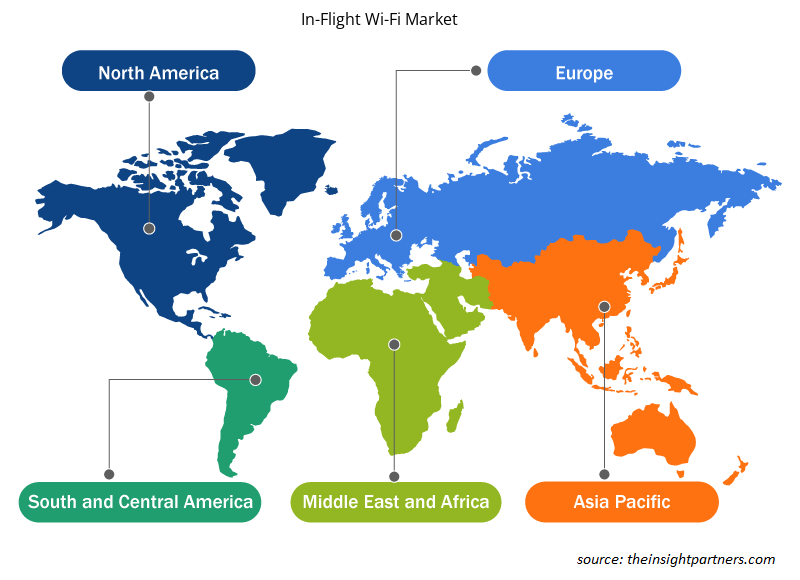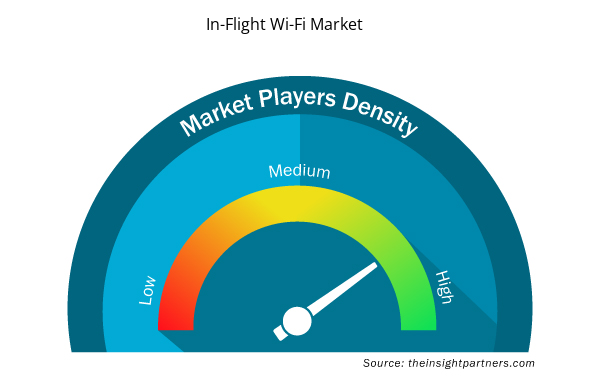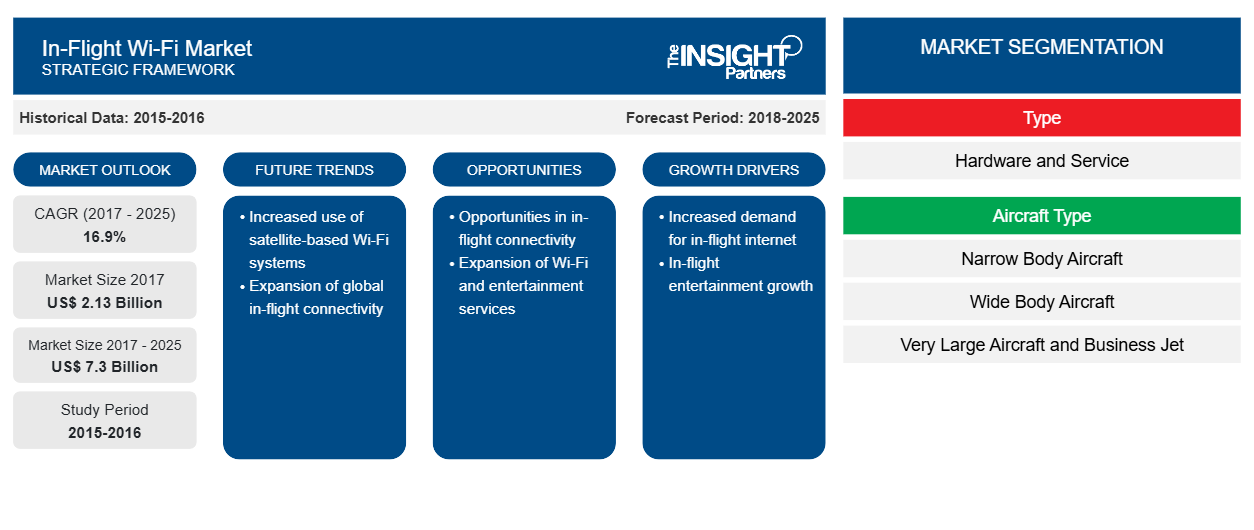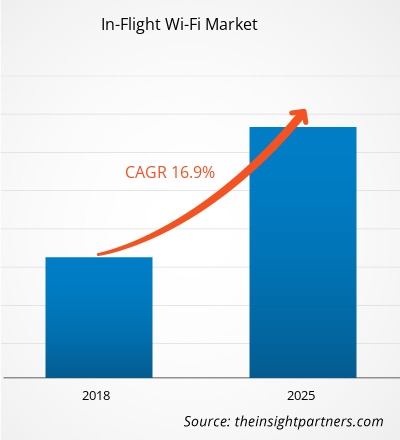Nel 2017, il mercato del Wi-Fi in volo era stimato in 2,13 miliardi di dollari USA e si prevede che raggiungerà i 7,30 miliardi di dollari USA entro il 2025; si prevede una crescita a un CAGR del 16,9% nel periodo 2018-2025.
Nella cultura odierna "sempre connessa", in particolare l'aspettativa dei viaggiatori d'affari che le compagnie aeree integrino tecnologie digitali, tra cui opzioni di connettività in volo tra gli aeromobili, sta crescendo. La crescita epica nell'uso di dispositivi elettronici da parte dei passeggeri ha anche evidentemente aumentato la domanda di connettività a bordo, in particolare per i voli a lungo raggio. Inoltre, poiché le compagnie aeree stesse sono sotto pressione per ricavare flussi di entrate aggiuntivi previsti in modo significativo, la connettività in volo (Wi-Fi) è considerata una strategia win-win poiché la maggior parte dei passeggeri a livello globale è disposta a pagare per la connessione Internet ad alta velocità durante i viaggi aerei.
Anche le compagnie aeree più piccole hanno iniziato a offrire servizi Wi-Fi per attrarre più clienti e competere con le grandi compagnie aeree globali. Nei prossimi anni, si prevede che il Wi-Fi in volo fornirà una velocità maggiore. Ad esempio, un'azienda come Inmarsat in collaborazione con altre aziende sta lavorando a una rete Wi-Fi satellitare ad alta capacità supportata da torri di terra. Si prevede che fornirà un servizio di banda larga ad alta larghezza di banda costante in aria. Gogo Inc., uno dei principali attori nel mercato del Wi-Fi in volo, ha assicurato di raggiungere una velocità fino a 70 Mbps utilizzando doppie antenne a banda Ku che si collegano al satellite. Inoltre, si prevede che la tecnologia Wi-Fi in volo satellitare fornirà una velocità fino a 70 Mbps con antenne potenziate. Mentre la tecnologia aria-terra, si prevede che i provider soddisfino una velocità Wi-Fi in volo fino a 100 Mbit/s. Con il miglioramento tecnologico nella connettività aria-terra e satellitare, si prevede che il Wi-Fi in volo offrirà una velocità migliore, un'esperienza migliorata, con costi ottimali. Si prevede che il mercato del Wi-Fi in volo prospererà nei prossimi anni grazie alla maggiore velocità di connessione e all'aumento del numero di rotte coperte.
Personalizza questo report in base alle tue esigenze
Riceverai la personalizzazione gratuita di qualsiasi report, comprese parti di questo report, o analisi a livello nazionale, pacchetto dati Excel, oltre a usufruire di grandi offerte e sconti per start-up e università
- Scopri le principali tendenze di mercato in questo rapporto.Questo campione GRATUITO includerà analisi di dati che spaziano dalle tendenze di mercato alle stime e alle previsioni.
Approfondimenti di mercato: mercato Wi-Fi in volo
Partnership di vendita al dettaglio in volo
Attualmente, tra le spese di viaggio complessive, la vendita al dettaglio in volo rappresenta solo circa il 5%. Grazie a una migliore connettività, le compagnie aeree ora offrono ai propri clienti la possibilità di fare shopping al dettaglio in volo. Ad esempio, compagnie come Swiss e British Airways consentono ai propri passeggeri di cercare e ordinare dal catalogo tramite smartphone e tablet. Inoltre, una migliore connettività in volo offre ai passeggeri esperienze di acquisto più rapide, semplici e sicure, che prima non erano possibili. Molte compagnie aeree hanno già iniziato a collaborare con i rivenditori, ad esempio Air China ha stretto una partnership con JD.com, uno dei rivenditori online, per fornire un servizio di consegna a domicilio e shopping in volo. Lufthansa, in collaborazione con il supermercato REWE, ha annunciato un progetto che consente ai passeggeri di ordinare generi alimentari tramite il servizio Wi-Fi in volo, che viene poi trasportato all'indirizzo di casa del viaggiatore all'orario scelto. Pertanto, la connettività Wi-Fi in volo crea opportunità per partnership di vendita al dettaglio e aumenta la crescita del mercato globale Wi-Fi in volo.
Tipo Segmento Insights
In base al tipo, il mercato del Wi-Fi in volo è segmentato in hardware e servizi. Il mercato dell'hardware è ulteriormente suddiviso in antenna, LAN wireless, dispositivo di punto di accesso e gateway hotspot. D'altro canto, il segmento dei servizi è categorizzato come servizio di integrazione e implementazione, servizio di progettazione e pianificazione di rete, servizio di supporto e altro. Attualmente, gli operatori delle compagnie aeree tendono sempre di più all'implementazione di sistemi Wi-Fi sui loro jet a fusoliera stretta, larga e business. Ciò è dovuto alla crescente domanda di intrattenimento in volo in tempo reale, con maggiore larghezza di banda. D'altro canto, anche il mercato dei servizi sta aumentando a un ritmo equo nel corso degli anni, in relazione alla domanda di assistenza e manutenzione dei sistemi Wi-Fi montati sugli aeromobili, a intervalli regolari.
Approfondimenti sul segmento del tipo di aeromobile
In base al tipo di aeromobile, il mercato del Wi-Fi in volo è suddiviso in aeromobili a fusoliera stretta, aeromobili a fusoliera larga, aeromobili molto grandi e jet aziendali. I sistemi Wi-Fi in volo sono installati su tutti e tre i tipi di aeromobili per migliorare l'esperienza del cliente durante il viaggio. Tra i tre tipi di aeromobili, gli aeromobili a fusoliera stretta sono per lo più dotati di sistemi Wi-Fi, poiché la maggior parte delle compagnie aeree che operano in tutto il mondo ha un numero enorme di aeromobili a fusoliera stretta nelle proprie flotte. Ad esempio, le principali compagnie aeree che hanno abilitato i sistemi Wi-Fi sul 100% delle proprie flotte includono Icelandair, SouthWest Airlines e Virgin Airlines. Southwest Airlines ha 716 aeromobili a fusoliera stretta, mentre Emirates ha 256 aeromobili a fusoliera larga che sono abilitati al Wi-Fi in volo. Queste statistiche mostrano la domanda di sistemi Wi-Fi tra i passeggeri a bordo in tutto
Approfondimenti sul segmento tecnologico
In base alla tecnologia, il mercato del Wi-Fi in volo è diviso in tecnologia aria-terra e tecnologia satellitare. La tecnologia Wi-Fi in volo aria-terra è la tecnologia più utilizzata tra le compagnie aeree. Ciò è dovuto alla semplicità dell'infrastruttura e al basso costo. D'altro canto, la tecnologia satellitare offre una connessione Internet migliore e ad alta velocità, tuttavia è costosa se confrontata con la tecnologia aria-terra. Questo fattore limita le compagnie aeree a optare per sistemi Wi-Fi in volo basati su satellite.
Gli operatori del mercato si concentrano su innovazioni e sviluppi di nuovi prodotti integrando tecnologie e funzionalità avanzate nei loro prodotti per competere con i concorrenti.
2018: Hughes di EchoStar annuncia un potenziamento del suo sistema JUPITER™, aggiungendo un rapido schema di analisi e prioritizzazione in rotta per fornire supporto alle applicazioni marittime.
2018: Global Eagle Entertainment Inc. ha annunciato che All Nippon Airways Trading Co., Ltd. ha assegnato un contratto triennale per servizi di intrattenimento e contenuti in volo a Global Eagle.
2018: La soluzione di connettività in volo 2Ku di GOGO è stata selezionata da Air Canada per il suo aeromobile Bombardier CS300. Con l'aiuto della connettività in volo 2Ku, Air Canada fornirà ai suoi clienti la possibilità di lavorare, comunicare in volo e divertirsi
Approfondimenti regionali sul mercato Wi-Fi in volo
Le tendenze regionali e i fattori che influenzano il mercato Wi-Fi in volo durante il periodo di previsione sono stati ampiamente spiegati dagli analisti di Insight Partners. Questa sezione discute anche i segmenti e la geografia del mercato Wi-Fi in volo in Nord America, Europa, Asia Pacifico, Medio Oriente e Africa e America meridionale e centrale.

- Ottieni i dati specifici regionali per il mercato Wi-Fi in volo
Ambito del rapporto sul mercato Wi-Fi in volo
| Attributo del report | Dettagli |
|---|---|
| Dimensioni del mercato nel 2017 | 2,13 miliardi di dollari USA |
| Dimensioni del mercato entro il 2025 | 7,3 miliardi di dollari USA |
| CAGR globale (2017-2025) | 16,9% |
| Dati storici | 2015-2016 |
| Periodo di previsione | 2018-2025 |
| Segmenti coperti | Per tipo
|
| Regioni e Paesi coperti | America del Nord
|
| Leader di mercato e profili aziendali chiave |
|
Densità degli attori del mercato: comprendere il suo impatto sulle dinamiche aziendali
Il mercato del Wi-Fi in volo sta crescendo rapidamente, spinto dalla crescente domanda degli utenti finali dovuta a fattori quali l'evoluzione delle preferenze dei consumatori, i progressi tecnologici e una maggiore consapevolezza dei vantaggi del prodotto. Con l'aumento della domanda, le aziende stanno ampliando le loro offerte, innovando per soddisfare le esigenze dei consumatori e capitalizzando sulle tendenze emergenti, il che alimenta ulteriormente la crescita del mercato.
La densità degli operatori di mercato si riferisce alla distribuzione di aziende o società che operano in un particolare mercato o settore. Indica quanti concorrenti (operatori di mercato) sono presenti in un dato spazio di mercato in relazione alle sue dimensioni o al valore di mercato totale.
Le principali aziende che operano nel mercato Wi-Fi in volo sono:
- CORPORAZIONE ECHOSTAR
- GLOBAL EAGLE INTRATTENIMENTO INC.
- Gogo LLC
- HONEYWELL INTERNAZIONALE INC.
- PANASONIC AVIONICS CORPORATION
Disclaimer : le aziende elencate sopra non sono classificate secondo un ordine particolare.

- Ottieni una panoramica dei principali attori del mercato Wi-Fi in volo
Il mercato globale del Wi-Fi in volo è stato segmentato come segue:
Mercato Wi-Fi in volo – Per tipo
- Hardware
- Servizio
Mercato Wi-Fi in volo – Per tipo di aeromobile
- Corpo stretto
- Aereo a fusoliera larga
- Aereo aziendale
Mercato Wi-Fi in volo – Per tecnologia
- Aria-Terra
- Satellitare
Mercato Wi-Fi in volo – per area geografica
America del Nord
- NOI
- Canada
- Messico
Europa
- Francia
- Germania
- Italia
- Regno Unito
- Russia
- Resto d'Europa
Asia Pacifico (APAC)
- Cina
- India
- Corea del Sud
- Giappone
- Resto dell'APAC
Medio Oriente e Africa (MEA)
- Sudafrica
- Resto del MEA
America del Sud (SAM)
- Brasile
- Argentina
- Resto del SAM
Mercato Wi-Fi in volo – Profili aziendali
- Società Echostar
- Aquila globale intrattenimento Inc
- Gogo LLC
- Honeywell International Inc
- Panasonic Avionics Corporation
- Viasat Inc
- Sito web air
- Gruppo Talete
- Soluzioni Thinkom Inc.
- Società per azioni Kymeta
- Analisi storica (2 anni), anno base, previsione (7 anni) con CAGR
- Analisi PEST e SWOT
- Valore/volume delle dimensioni del mercato - Globale, regionale, nazionale
- Industria e panorama competitivo
- Set di dati Excel



Report Coverage
Revenue forecast, Company Analysis, Industry landscape, Growth factors, and Trends

Segment Covered
This text is related
to segments covered.

Regional Scope
North America, Europe, Asia Pacific, Middle East & Africa, South & Central America

Country Scope
This text is related
to country scope.
Trends and growth analysis reports related to Electronics and Semiconductor : READ MORE..
The List of Companies
1. ECHOSTAR CORPORATION
2. GLOBAL EAGLE ENTERTAINMENT INC
3. GOGO LLC
4. HONEYWELL INTERNATIONAL INC
5. PANASONIC AVIONICS CORPORATION
6. VIASAT INC
7. SITAONAIR
8. THALES GROUP
9. THINKOM SOLUTIONS INC
10. KYMETA CORPORATION
The Insight Partners performs research in 4 major stages: Data Collection & Secondary Research, Primary Research, Data Analysis and Data Triangulation & Final Review.
- Data Collection and Secondary Research:
As a market research and consulting firm operating from a decade, we have published and advised several client across the globe. First step for any study will start with an assessment of currently available data and insights from existing reports. Further, historical and current market information is collected from Investor Presentations, Annual Reports, SEC Filings, etc., and other information related to company’s performance and market positioning are gathered from Paid Databases (Factiva, Hoovers, and Reuters) and various other publications available in public domain.
Several associations trade associates, technical forums, institutes, societies and organization are accessed to gain technical as well as market related insights through their publications such as research papers, blogs and press releases related to the studies are referred to get cues about the market. Further, white papers, journals, magazines, and other news articles published in last 3 years are scrutinized and analyzed to understand the current market trends.
- Primary Research:
The primarily interview analysis comprise of data obtained from industry participants interview and answers to survey questions gathered by in-house primary team.
For primary research, interviews are conducted with industry experts/CEOs/Marketing Managers/VPs/Subject Matter Experts from both demand and supply side to get a 360-degree view of the market. The primary team conducts several interviews based on the complexity of the markets to understand the various market trends and dynamics which makes research more credible and precise.
A typical research interview fulfils the following functions:
- Provides first-hand information on the market size, market trends, growth trends, competitive landscape, and outlook
- Validates and strengthens in-house secondary research findings
- Develops the analysis team’s expertise and market understanding
Primary research involves email interactions and telephone interviews for each market, category, segment, and sub-segment across geographies. The participants who typically take part in such a process include, but are not limited to:
- Industry participants: VPs, business development managers, market intelligence managers and national sales managers
- Outside experts: Valuation experts, research analysts and key opinion leaders specializing in the electronics and semiconductor industry.
Below is the breakup of our primary respondents by company, designation, and region:

Once we receive the confirmation from primary research sources or primary respondents, we finalize the base year market estimation and forecast the data as per the macroeconomic and microeconomic factors assessed during data collection.
- Data Analysis:
Once data is validated through both secondary as well as primary respondents, we finalize the market estimations by hypothesis formulation and factor analysis at regional and country level.
- Macro-Economic Factor Analysis:
We analyse macroeconomic indicators such the gross domestic product (GDP), increase in the demand for goods and services across industries, technological advancement, regional economic growth, governmental policies, the influence of COVID-19, PEST analysis, and other aspects. This analysis aids in setting benchmarks for various nations/regions and approximating market splits. Additionally, the general trend of the aforementioned components aid in determining the market's development possibilities.
- Country Level Data:
Various factors that are especially aligned to the country are taken into account to determine the market size for a certain area and country, including the presence of vendors, such as headquarters and offices, the country's GDP, demand patterns, and industry growth. To comprehend the market dynamics for the nation, a number of growth variables, inhibitors, application areas, and current market trends are researched. The aforementioned elements aid in determining the country's overall market's growth potential.
- Company Profile:
The “Table of Contents” is formulated by listing and analyzing more than 25 - 30 companies operating in the market ecosystem across geographies. However, we profile only 10 companies as a standard practice in our syndicate reports. These 10 companies comprise leading, emerging, and regional players. Nonetheless, our analysis is not restricted to the 10 listed companies, we also analyze other companies present in the market to develop a holistic view and understand the prevailing trends. The “Company Profiles” section in the report covers key facts, business description, products & services, financial information, SWOT analysis, and key developments. The financial information presented is extracted from the annual reports and official documents of the publicly listed companies. Upon collecting the information for the sections of respective companies, we verify them via various primary sources and then compile the data in respective company profiles. The company level information helps us in deriving the base number as well as in forecasting the market size.
- Developing Base Number:
Aggregation of sales statistics (2020-2022) and macro-economic factor, and other secondary and primary research insights are utilized to arrive at base number and related market shares for 2022. The data gaps are identified in this step and relevant market data is analyzed, collected from paid primary interviews or databases. On finalizing the base year market size, forecasts are developed on the basis of macro-economic, industry and market growth factors and company level analysis.
- Data Triangulation and Final Review:
The market findings and base year market size calculations are validated from supply as well as demand side. Demand side validations are based on macro-economic factor analysis and benchmarks for respective regions and countries. In case of supply side validations, revenues of major companies are estimated (in case not available) based on industry benchmark, approximate number of employees, product portfolio, and primary interviews revenues are gathered. Further revenue from target product/service segment is assessed to avoid overshooting of market statistics. In case of heavy deviations between supply and demand side values, all thes steps are repeated to achieve synchronization.
We follow an iterative model, wherein we share our research findings with Subject Matter Experts (SME’s) and Key Opinion Leaders (KOLs) until consensus view of the market is not formulated – this model negates any drastic deviation in the opinions of experts. Only validated and universally acceptable research findings are quoted in our reports.
We have important check points that we use to validate our research findings – which we call – data triangulation, where we validate the information, we generate from secondary sources with primary interviews and then we re-validate with our internal data bases and Subject matter experts. This comprehensive model enables us to deliver high quality, reliable data in shortest possible time.


 Ottieni un campione gratuito per questo repot
Ottieni un campione gratuito per questo repot